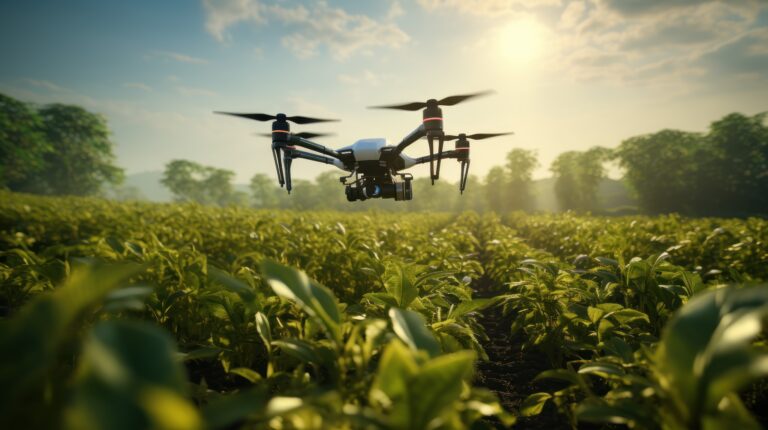
The world faces a dual challenge: feeding a growing population and protecting our planet. Agribusiness innovation is sprouting solutions, and Uganda, Africa, and the world are taking root in this fertile ground. Let’s explore key tech advances transforming animal keeping and crop production, along with their impact and future potential.
Precision Takes Center Stage:
Data-driven Decisions: Traditional methods rely on experience and intuition, often leading to over or under-application of resources. Sensors and satellite imagery provide real-time data, enabling farmers to make informed decisions on water, fertilizer, and pesticide use. Benefits: Increased yields, reduced waste, improved resource management. The internet plays a vital role here, transmitting data and connecting farmers to online platforms with weather forecasts, market information, and expert advice.
The Rise of Drones: These unmanned aerial vehicles (UAVs) are revolutionizing agriculture. Previously, scouting fields for pests involved laborious manual work. Drones equipped with cameras and sensors map fields, identify pest outbreaks much faster, and even precisely apply crop treatments. Herders in Uganda are using drones to monitor vast grazing lands and track livestock movement, replacing time-consuming horseback patrols. Benefits: Increased efficiency, reduced labor costs, targeted pest control.
Smarter Animal Husbandry:
Precision Livestock Farming: Traditionally, animal health monitoring relied on visual inspection. Sensors implanted in animals or worn on collars provide real-time data on health, movement, and even stress levels. This allows for early disease detection, optimized feeding regimens based on individual animal needs, and improved animal welfare. Benefits: Reduced disease outbreaks, improved animal productivity, better quality products.
Digital Traceability: Blockchain technology is creating tamper-proof records of an animal’s journey from farm to fork. This enhances food safety by tracking origins and identifying potential contamination points. It also combats fraud and opens doors to premium markets for Ugandan farmers who can showcase their ethical and sustainable practices. Benefits: Increased consumer confidence, higher market access, fairer pricing for farmers.
Breeding a Better Future:
Gene Editing: While this technology is still in its early stages, it holds immense potential for creating crops resistant to pests, diseases, and drought. This could be a game-changer for African agriculture, particularly in regions vulnerable to climate change. Benefits: Increased crop resilience, improved food security, reduced reliance on pesticides.
Biotechnology and Improved Varieties: Developing disease-resistant and high-yielding crop varieties is crucial for food security. Cassava, a major Ugandan food source, is benefiting from research into varieties resistant to cassava mosaic disease, a devastating crop plague. Benefits: Reduced crop losses, increased food production, improved dietary diversity.
Beyond the Farm:
Data Analytics and AI: The vast amount of data generated by sensors, drones, and other technologies can be harnessed through data analytics and artificial intelligence (AI). These tools can identify patterns, predict trends, and optimize agricultural practices for even greater efficiency and sustainability. For instance, AI can analyze weather data and historical yields to suggest optimal planting times and fertilizer application rates. Benefits: Improved decision-making, resource optimization, proactive risk management.
Automated Machinery and Robotics: From automated milking machines to self-driving tractors, robotics are making inroads into agriculture. While these technologies may have a larger initial investment, they offer increased efficiency and reduced reliance on manual labor. This can be particularly advantageous for large-scale farms or those struggling to find qualified labor. Benefits: Reduced labor costs, increased productivity, improved working conditions for farmers.
Impact on Employment:
The automation of some tasks may lead to a shift in the agricultural workforce, with a decrease in demand for manual labor and an increase in demand for skilled workers who can operate and maintain complex technologies. Training programs and support systems are crucial to ensure a smooth transition and equip farmers with the skills to thrive in this evolving landscape.
Challenges in Adopting New Technologies:
Accessibility and Affordability: Tech innovations can be expensive, putting them out of reach for small-scale farmers, the backbone of agriculture in many developing countries. Initiatives are underway to bridge this gap through government subsidies, mobile phone-based solutions that require less investment and can be readily adopted by farmers familiar with mobile technology, and farmer cooperatives that allow for shared resources and knowledge.
Infrastructure and Connectivity: Rural areas often lack reliable internet access, hindering the adoption of digital tools. Investments in infrastructure and innovative offline solutions, such as data storage on local servers or the use of SMS-based alerts, are crucial to ensure everyone can benefit from these advancements.
The Future is Green:
Technological advancements offer a path towards sustainable agriculture. By optimizing resource use and minimizing environmental impact, these innovations can ensure food security for a growing global population.
Here are some exciting trends to watch in agribusiness technology:
Vertical Farming: This method involves growing crops in vertically stacked layers, often indoors. It uses less water and land, making it ideal for urban areas and regions with limited resources.
Agricultural Robotics: Expect more sophisticated robots capable of performing tasks like fruit picking, weed removal, and even planting seeds. This will further improve efficiency and reduce reliance on manual labor.
Internet of Things (IoT): The seamless integration of sensors and devices with the internet will create a network of “smart farms” that can autonomously monitor and adjust growing conditions.
Big Data for Sustainability: Advanced data analysis will help farmers optimize resource use, minimize waste, and track their environmental footprint. This will promote sustainable practices and responsible land management.
As Uganda, Africa, and the world embrace these technologies, we can cultivate a brighter future for generations to come. By fostering innovation, investing in infrastructure, and ensuring equitable access, we can create a food system that is not only productive but also sustainable and resilient.
In conclusion, the agribusiness revolution is transforming the way we grow food. Technology offers immense potential to address global challenges and create a more secure and sustainable food future for all.
